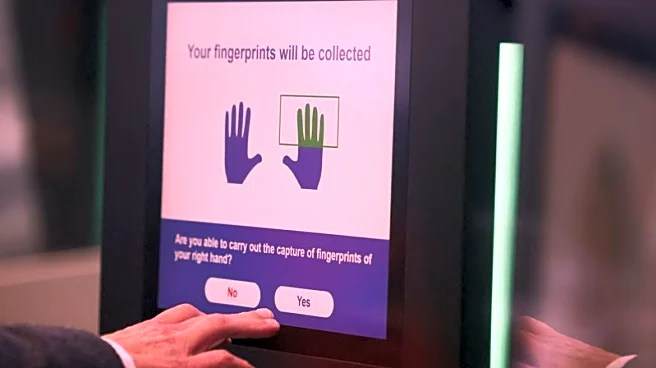What's Happening?
The European Union is set to implement a new biometric Entry/Exit System (EES) at its borders starting October 12. This system will record entries and exits of non-EU travelers, replacing manual passport checks with automated procedures that collect facial images and fingerprints. The EES aims to monitor the duration of stays within the Schengen area, automatically detecting overstays beyond the 90-day limit within a 180-day period. The system is part of preparations for the ETIAS electronic travel authorization program, which will be introduced in 2026. The EES will be rolled out across 29 participating countries by April 2026, with the goal of speeding up border processing, reducing identity fraud, and supporting efforts against terrorism and organized crime. The biometric data collected will be used to verify travelers' identities while maintaining privacy and data protection standards.
Why It's Important?
The introduction of the EES is significant as it represents a shift towards more secure and efficient border management within the EU. By automating the collection of biometric data, the system aims to enhance security measures and streamline the entry process for non-EU travelers. This development could impact U.S. citizens traveling to Europe, as they will be subject to these new procedures. The system's ability to detect overstays may also influence travel patterns and compliance with visa regulations. Additionally, the EES is expected to contribute to broader efforts in combating identity fraud and organized crime, potentially affecting international security dynamics.
What's Next?
Following the implementation of the EES, the EU plans to introduce the ETIAS travel authorization system towards the end of 2026. This online pre-approval system will be required for travelers from visa-exempt countries, including the United States, Canada, and Australia. The ETIAS authorization will cost €20 and remain valid for three years. As these systems are rolled out, travelers and stakeholders will need to adapt to the new requirements, potentially influencing travel industry practices and policies. The effectiveness of these systems in achieving their security and efficiency goals will likely be monitored and assessed by EU officials and international observers.
Beyond the Headlines
The shift to biometric border checks raises questions about privacy and data protection, as the collection and storage of sensitive personal information become more prevalent. While the EU has committed to maintaining privacy standards, the implementation of such systems may spark debates on the balance between security and individual rights. Additionally, the move could set a precedent for other regions considering similar measures, influencing global trends in border security and immigration policy.












